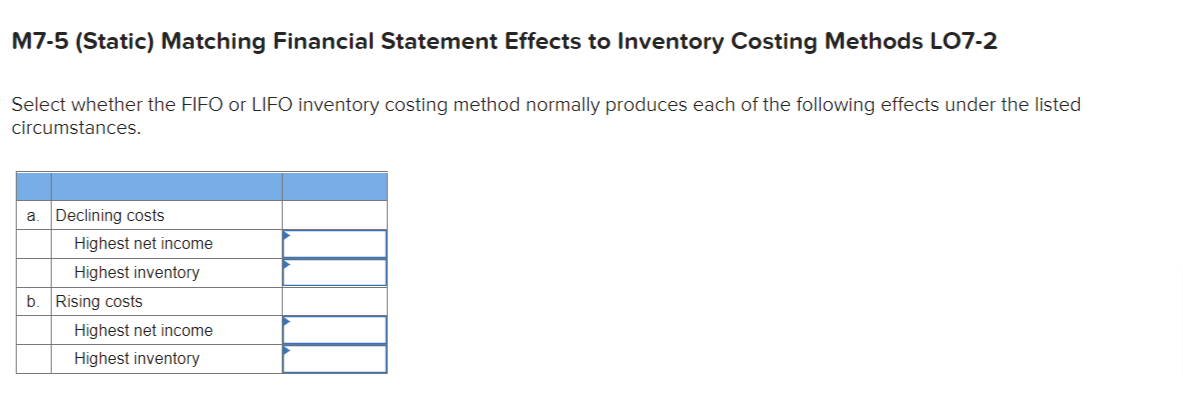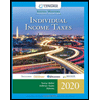M7-5 (Static) Matching Financial Statement Effects to Inventory Costing Methods LO7-2 Select whether the FIFO or LIFO inventory costing method normally produces each of the following effects under the listed circumstances. a. Declining costs Highest net income Highest inventory b. Rising costs Highest net income Highest inventory
M7-5 (Static) Matching Financial Statement Effects to Inventory Costing Methods LO7-2 Select whether the FIFO or LIFO inventory costing method normally produces each of the following effects under the listed circumstances. a. Declining costs Highest net income Highest inventory b. Rising costs Highest net income Highest inventory
Cornerstones of Financial Accounting
4th Edition
ISBN:9781337690881
Author:Jay Rich, Jeff Jones
Publisher:Jay Rich, Jeff Jones
Chapter6: Cost Of Goods Sold And Inventory
Section: Chapter Questions
Problem 50E: Inventory Costing Methods Crandall Distributors uses a perpetual inventory system and has the...
Related questions
Topic Video
Question

Transcribed Image Text:M7-5 (Static) Matching Financial Statement Effects to Inventory Costing Methods LO7-2
Select whether the FIFO or LIFO inventory costing method normally produces each of the following effects under the listed
circumstances.
a. Declining costs
b.
Highest net income
Highest inventory
Rising costs
Highest net income
Highest inventory
![!
Required information
E7-11 (Static) Evaluating the Choice among Three Alternative Inventory Methods Based on Income and
Cash Flow Effects LO7-2, 7-3
[The following information applies to the questions displayed below.]
Daniel Company uses a periodic inventory system. Data for the current year: beginning merchandise inventory (ending
inventory December 31, prior year), 2,000 units at $38; purchases, 8,000 units at $40; expenses (excluding income taxes),
$184,500; ending inventory per physical count at December 31, current year, 1,800 units; sales, 8,200 units; sales price per
unit, $75; and average income tax rate, 30 percent.
E7-11 Part 3
3. Between FIFO and LIFO, which method is preferable in terms of (a) net income and (b) income taxes paid (cash flow), assuming that
prices were falling?
Net income
Income taxes paid (cash flow)](/v2/_next/image?url=https%3A%2F%2Fcontent.bartleby.com%2Fqna-images%2Fquestion%2F266d5c88-4132-4eca-8561-6ebd3b0393f5%2Ff2b735bf-68cb-47b0-80f3-cc53ec93ae86%2F0lp7gie_processed.png&w=3840&q=75)
Transcribed Image Text:!
Required information
E7-11 (Static) Evaluating the Choice among Three Alternative Inventory Methods Based on Income and
Cash Flow Effects LO7-2, 7-3
[The following information applies to the questions displayed below.]
Daniel Company uses a periodic inventory system. Data for the current year: beginning merchandise inventory (ending
inventory December 31, prior year), 2,000 units at $38; purchases, 8,000 units at $40; expenses (excluding income taxes),
$184,500; ending inventory per physical count at December 31, current year, 1,800 units; sales, 8,200 units; sales price per
unit, $75; and average income tax rate, 30 percent.
E7-11 Part 3
3. Between FIFO and LIFO, which method is preferable in terms of (a) net income and (b) income taxes paid (cash flow), assuming that
prices were falling?
Net income
Income taxes paid (cash flow)
Expert Solution
This question has been solved!
Explore an expertly crafted, step-by-step solution for a thorough understanding of key concepts.
This is a popular solution!
Trending now
This is a popular solution!
Step by step
Solved in 3 steps

Knowledge Booster
Learn more about
Need a deep-dive on the concept behind this application? Look no further. Learn more about this topic, accounting and related others by exploring similar questions and additional content below.Recommended textbooks for you

Cornerstones of Financial Accounting
Accounting
ISBN:
9781337690881
Author:
Jay Rich, Jeff Jones
Publisher:
Cengage Learning

Intermediate Accounting: Reporting And Analysis
Accounting
ISBN:
9781337788281
Author:
James M. Wahlen, Jefferson P. Jones, Donald Pagach
Publisher:
Cengage Learning


Cornerstones of Financial Accounting
Accounting
ISBN:
9781337690881
Author:
Jay Rich, Jeff Jones
Publisher:
Cengage Learning

Intermediate Accounting: Reporting And Analysis
Accounting
ISBN:
9781337788281
Author:
James M. Wahlen, Jefferson P. Jones, Donald Pagach
Publisher:
Cengage Learning


Individual Income Taxes
Accounting
ISBN:
9780357109731
Author:
Hoffman
Publisher:
CENGAGE LEARNING - CONSIGNMENT

College Accounting, Chapters 1-27
Accounting
ISBN:
9781337794756
Author:
HEINTZ, James A.
Publisher:
Cengage Learning,

Survey of Accounting (Accounting I)
Accounting
ISBN:
9781305961883
Author:
Carl Warren
Publisher:
Cengage Learning